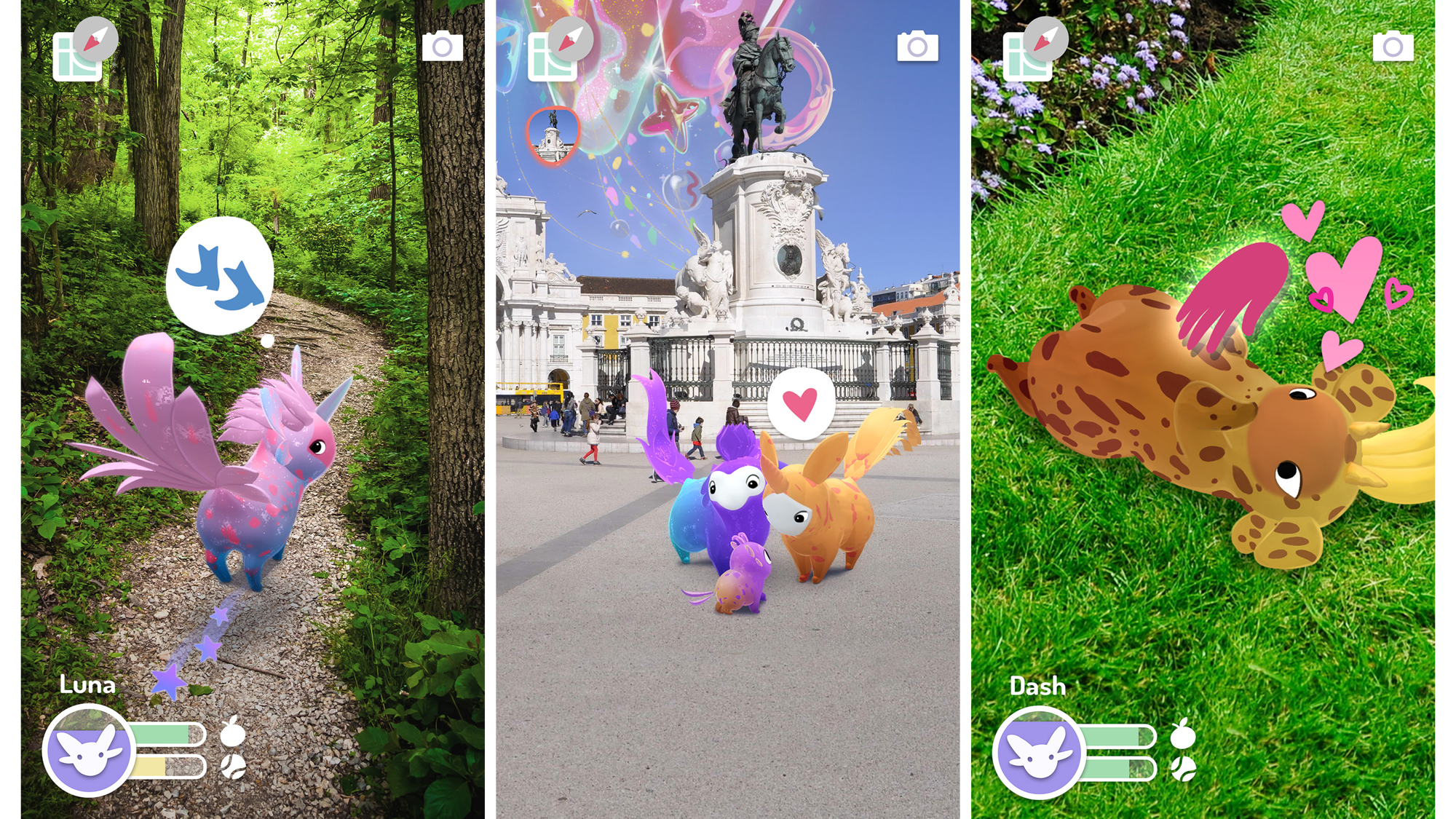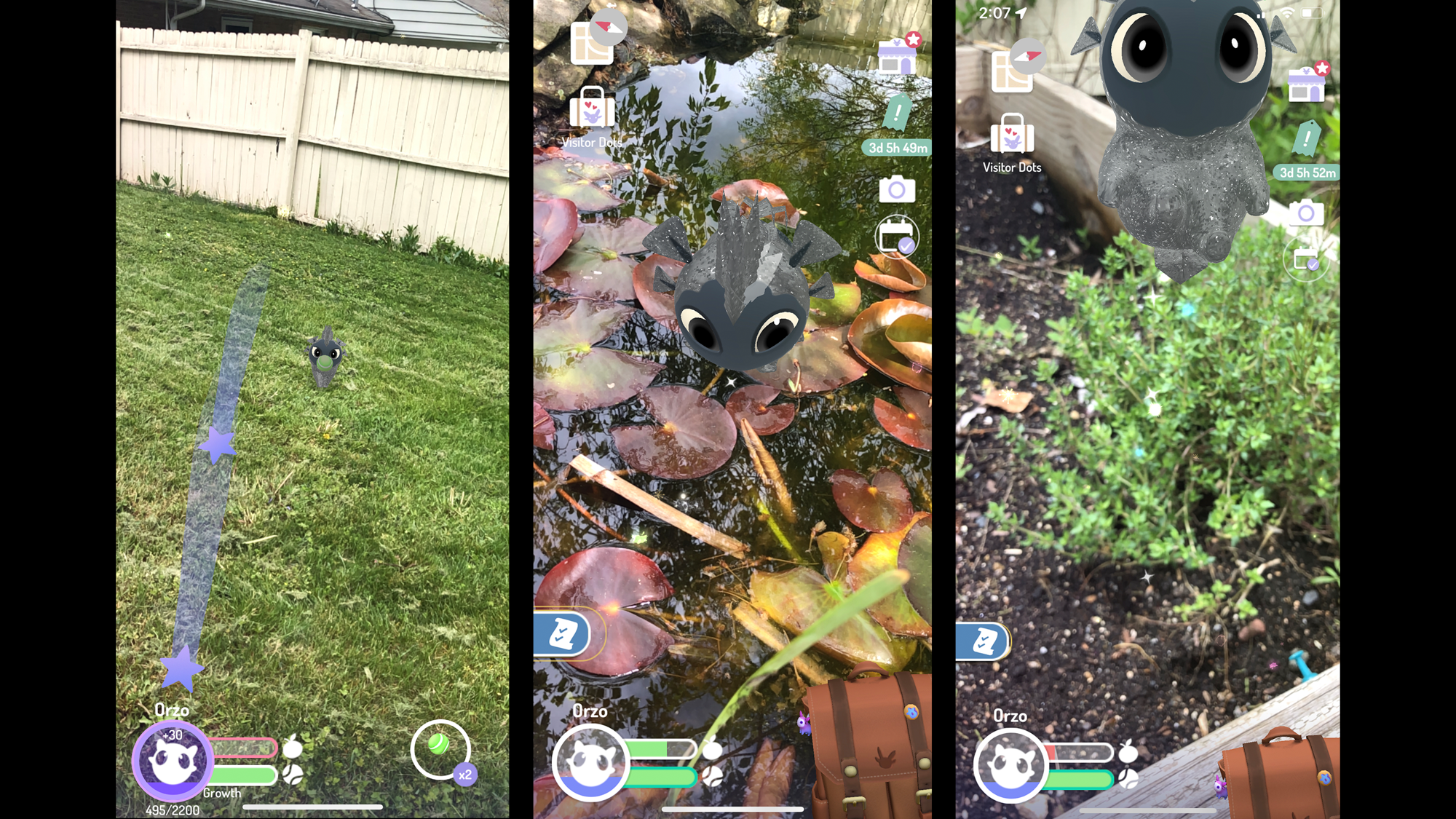A first look at Peridot, the new AR game from the creators of Pokémon Go
Peridot is a “modern-day spin on the original Tamagochi.” But will it be the second AR game to break through?

My pet Orzo was panting, excited to bring me the tennis ball I had thrown a few feet away. Orzo’s eyes were bright and it wagged its tail. “Good job, buddy!” I cooed. Orzo indicated it wanted a belly rub, so I obliged.
Orzo is not a real pet. It is a virtual creature on Peridot, a new mobile augmented-reality game from Niantic, the company behind Pokémon Go, that’s launching in app stores today. The idea of the game is for players to raise and nurture Dots, the term used for its cadre of cartoonish characters. I got a sneak preview of what it’s like ahead of today’s release.
Peridot is heavily inspired by Tamagotchi, the virtual-pet phenomenon of the ’90s. “Peridot is the modern-day spin on the original Tamagotchi,” Ziah Fogel, Peridot’s director of product, said at a press preview last Wednesday.
That’s an accurate summary of the game. When you look at your surroundings through the app, you can see your virtual pet running, hiding, and navigating around real-life obstacles. The pets are cute enough, and as someone who wants a pet and loves animals, it gave me similar fuzzy feelings to actually having one. However, I found the game play a little repetitive, and the game drained my phone’s battery unbelievably quickly.
The big question is whether Niantic can re-create the success of its blockbuster game Pokémon Go, which became a cultural phenomenon in 2016 as players chased characters in a frenzy to score rewards. Niantic followed up with games inspired by other franchises like Harry Potter, Catan, and Transformers, but this is its first original in-house game since Ingress, the company’s first AR game in 2014. A lot is riding on it.
With Peridot, Niantic is veering away from franchises and creating an entirely new world with new characters. All Dots are unique, according to the company, created using in-house algorithms that mash together creatures inspired by the real (for example, cheetahs), the legendary (yeti), and the imaginary (unicorns). Other algorithms affect physical attributes like skin texture and plumage. When Dots mate with each other, an entirely new being “hatches,” each combining Dots parents’ algorithmically derived genetic code.
Fogel said these algorithms ensure that no two Dots will ever be alike: “The number of combinations—2.3 x 1024—surpasses the number of stars in the universe and granules of sand on Earth.”
Like Tamagotchi, the game begins with an egg. I chose a granite one, which cracked open to reveal a round, fluffy silver animal with huge anime eyes. I had just made a grocery list before playing, which was probably why I decided to name my virtual pet Orzo. In my dimly lit office, Orzo ping-ponged off the walls, "foraged" into the carpet to unearth a snack, and then cuddled next to me, cooing after I “petted” it by rubbing its tummy on my iPhone screen.
While my Dot was “born” in my home, the virtual creatures are not intended to be homebound. Niantic sees Peridot as an outdoor game, just like Pokémon Go. "We want to inspire daily movement," says Fogel.
Peridot does this by rewarding players with prizes for milestone numbers of steps they’ve taken or distances they’ve traveled while using the app. It also suggests local points of interest, like parks where people can take their Dots to hunt for food or trophies.

So I took Orzo for a spin in my backyard the next day. I played fetch with it and tried out “foraging”: I drew a circle on my phone, and Orzo searched within the AR-generated space, sometimes finding food like a sandwich. The real-time mapping abilities of Peridot’s AR shined here, as Orzo was able to scurry into leaves, sit atop a puddle, and avoid a pole, convincingly becoming a part of the world as I viewed it through my phone. Strangely, the AR could not sense my shoe, and Orzo melted into it like a ghost, breaking the immersive illusion.
Like other games, including Pokémon Go before it, Peridot hopes to make money by getting players to buy in-game add-ons: accessories and treats for their pets, and even more Dots. Prices for these sorts of extras range from $2.99 to $99.99 in the beta version. Niantic is attempting to make money outside the game as well by selling physical merchandise through a partnership with Amazon, which will debut an in-app shopping experience called Amazon Anywhere.
Niantic is trying to differentiate Peridot by concentrating on its coziness instead of the chase-and-capture mechanics of Pokémon Go. Cozy video games, like Animal Crossing and Stardew Valley, became popular during the coronavirus pandemic by focusing less on violence and competition and more on nurturing an animal or an entire farm. The repetitive actions rewarded consistency over joystick skill and offered a soothing, comforting vibe.
Technically, Peridot is fairly smooth. The real-time mapping mostly works, despite some hiccups. However, smartphone AR is a battery drain: after I’d spent 15 minutes playing with Orzo, my fully charged iPhone X was down to 15%.
Fogel admitted that battery drain was an issue in beta testing, saying that Niantic recommends Peridot run on “higher-end devices” like the iPhone 8 and above or Android models from the last few years. She suggested that players limit themselves to shorter sessions to save battery or run the app in the background to count steps. “It’s hard on a device to run AR all the time. It heats up devices. We encourage shorter game play,” she said.
Wolfgang Broll, who heads the Virtual Worlds and Digital Games Lab at the Ilmenau University of Technology in Germany, believes the fact that Peridot is still trapped on a smartphone screen will be an issue. He thinks AR games really need AR glasses to take off. (Niantic says it will remaster Peridot if and when AR glasses become available.)
That may be, but as I write this, I’ve had Peridot for 48 hours and I’m already bored by it. If I were a child or someone using AR for the first time, I might have played longer. Orzo is cute and impressed me with its ability to dash around objects, but it might take more than endearing animals and decent technical skill for Peridot to change the AR gaming landscape.
Updated: This article has been amended to specify the name of Amazon's in-app shopping service, Amazon Anywhere.
Deep Dive
Humans and technology
Building a more reliable supply chain
Rapidly advancing technologies are building the modern supply chain, making transparent, collaborative, and data-driven systems a reality.
Building a data-driven health-care ecosystem
Harnessing data to improve the equity, affordability, and quality of the health care system.
Let’s not make the same mistakes with AI that we made with social media
Social media’s unregulated evolution over the past decade holds a lot of lessons that apply directly to AI companies and technologies.
Stay connected
Get the latest updates from
MIT Technology Review
Discover special offers, top stories, upcoming events, and more.